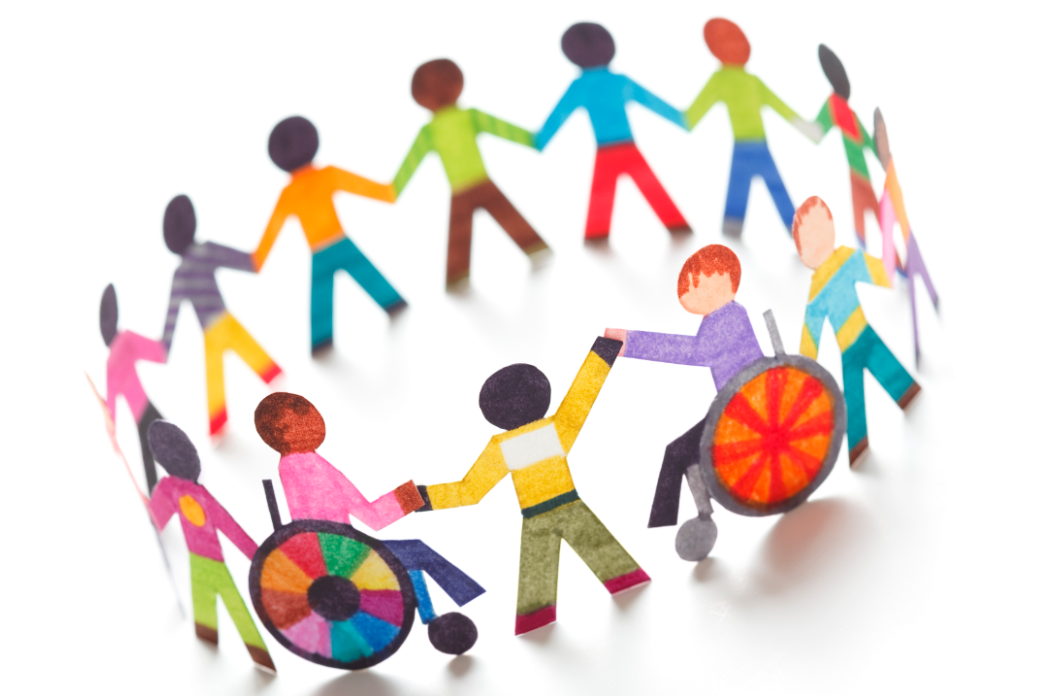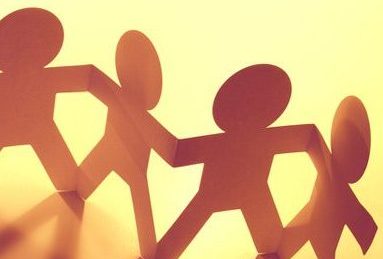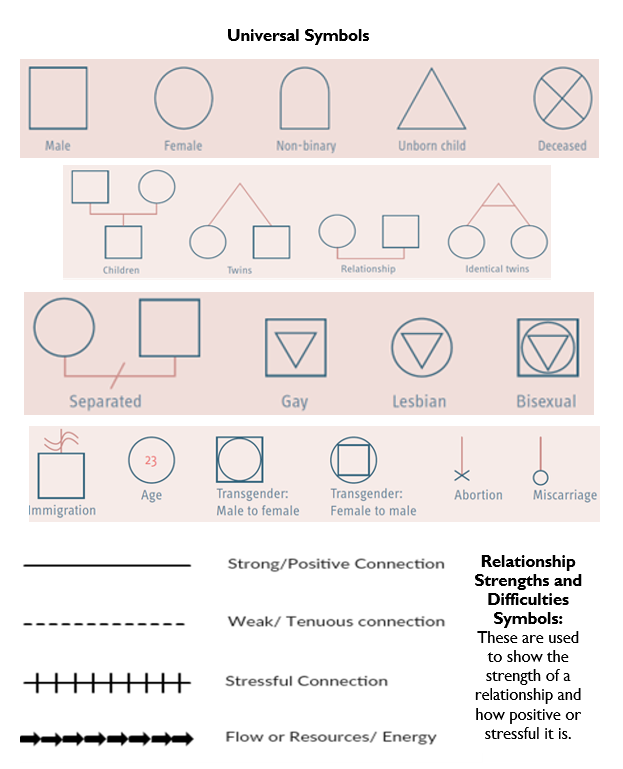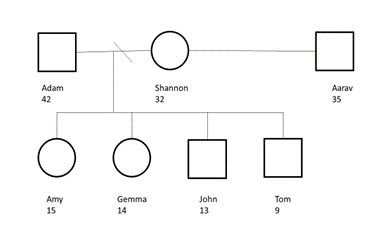
Get Mapping: A Picture Can be Worth a Thousand Words
What is a genogram?
A genogram is a visual picture of who is in a family and the nature of relationships. Although ‘doing’ a genogram is helpful, its greatest value comes from exploring what it is telling you about a family, taking an analytical approach and using this to inform your future work. Patterns in a family history can suddenly jump out in a visual map and help consider the emotions and circumstances underpinning the patterns. They also help identify important and trusted people in a child or adult’s life that can support safety or alternatively highlight worries for safety.
Symbols
Whilst there is some variation in the symbols and structures used to complete a genogram, there is general acceptance on the universal symbols. The main universal symbols used are shown here and a template can be downloaded below.
These universal symbols are used to describe individuals and their relationship to each other.

Try Doing Your Own
As a reflective exercise, it can be useful to do your own genogram. This may help you experience and understand the process and emotions involved when doing a genogram in your practice. Reflecting on and seeing your family relationships mapped out can be a powerful process. Think about when is a good time for you to do your genogram and who you may want to have a conversation with afterwards if it raises any issues for you.
Genograms in Practice
Genograms can be used at any point in your work. Initially you might want to sketch out a genogram based on your knowledge or information received about a family. This can help you to quickly gain an understanding of who is in a family and even through a basic genogram highlight areas for further exploration through being professionally curious.
What questions does this basic genogram to the right-hand side raise for you?
It could be that you wondered about the age gap between Adam and Shannon of 10 years. Looking at the ages of the children, this means that Shannon was 17 when she had her first child, Amy, and Adam was 27.
Were there safeguarding concerns at the time Shannon and Adam met in relation to Adam having contact with Shannon? Shannon and Adam had 3 children in quick succession. What did that mean for Shannon’s experience of being a mother at a young age and Adam’s experience of fatherhood? How did this then translate into what life was like for the children?
The children have two males in their lives. What are their relationships like with each other and the children?
Creating genograms with families:
Creating a genogram can be a powerful thing to do and, for adults in a family, can bring up painful memories of previous or current trauma. For this reason, it is important that when doing a genogram with a family to explain what it is and how it can raise sensitive issues. Having a trusted professional relationship with the adults can help ensure a safe space for discussion. Use your professional judgement in deciding when to do a genogram with a family and who should be involved.
Think about how to translate the questions the genogram raises for you, into a sensitive and curious conversation with the family. Using the genogram example above and the query relating to the age gap between Shannon and Adam when they first met and any safeguarding issues at the time, you may want to explore this with Shannon by herself. You could notice back to Shannon the age gap and ask her to tell you about how they met, what was happening in her life at the time, how did others around her feel about them being together?
Use open ended questions to gain as full a picture as possible. For example, asking someone if they are in a relationship may get a no response. However, it may well be that there is someone the child is coming into contact with but the parent doesn’t ‘feel’ they are in a relationship together. Asking a parent if there anyone in their lives they have met recently (either in person or online), visits the home or sees a child may lead to a different response. Use your personality and relationship with a family to help decide on the most useful style of discussion.
As much as genograms are useful tools for practitioners, they have equal value for families in helping to explore what is important to them and gain insights into their own family patterns, which subsequently can be the start of change. So, don’t worry if the genogram created with a family looks messy. Its value is in the discussion and understanding gained through doing it. Your agency may have an electronic way of recording a genogram on your systems.
Some of the symbols used can appear insensitive. For example, the X symbol to represent a death in the family can feel clinical and lack feeling. Ask the family what symbols they would like to use or use art/craft materials to represent the genogram.
Creating genograms with children:
Being mindful of the emotions involved in doing a genogram is perhaps even more important when completing one with a child. Think about the appropriateness and timing. There’s no right way of constructing a genogram with a child but preparation and creativity is crucial. Explain in language they can understand what a genogram is and importantly why it is helpful. For example, in the Plymouth Child Safeguarding Practice Review for Young Person A, their grandfather was a positive influence in their life but he didn’t feature in the support plan. Likewise, Young Person A’s brother was also exposed to the challenges within the family but the impact for him was unclear. Sharing with a child that you would love to hear about who is in their life so you can best help them demonstrates a genuine care and interest in their world.
Be led by the child. Ask them where they would like to start, with themselves, their parents, do they want to include pets, friends etc? Do they want to draw/create the genogram themselves using any art materials in replace of the symbols etc. It’s important that whatever the child creates is their perception so don’t worry too much about accuracy.
Some descriptions may need clarifying. Children might describe individuals as aunts, uncles, granny etc but are not technically related to them. You could explore this by saying….’That’s great to hear about Auntie Sam, how are you related to them?’

Genograms can help children look at how their family has changed and who has come into and out of their life. These complicated relations can be an additional source of stress for children because the changes are difficult to understand.
A useful way of doing this is by checking if there is anyone who the child would like in their genogram, or who used to be there but is no longer.

It is also very important to be sensitive to a child’s understanding of relationships. For example, issues of paternity or other brothers and sisters not known to them. Always check with the adults in a family what the child’s awareness of family relationships is.
General Principles
Families tell us how difficult it is to have to repeat their story and experience to agency after agency. Think about what this means for you in suggesting doing a genogram. Have they done it already with any other agency or worker and what was their experience? Has anything changed since then? How can you add to existing work or add value by doing it a different way?
We’ve mentioned how emotional doing a genogram can be, but it is important to recognise that it can also be a positive experience for families and children. Crucially, it can make sure that family strengths and networks can be identified and brought into support plans.
Ideally, genograms should cover at least three generations. However, if you do not have this information, in itself that is useful for analysis. Does it mean a lack of family support? Is the family isolated? Is there trauma in previous generations that parents don’t want to revisit or known?
Your organisation may have particular expectations about when and how to complete a genogram so please check with your agency requirements and practice standards.
Use your supervision or workplace support systems to make genograms purposeful for a family. If you are a supervisor or manage others, ask to explore a family genogram to inform practice going forward.


